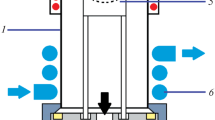Abstract
Thermal ionization isotope dilution mass spectrometry (TI-IDMS) was used as an oligo-element method for the determination of Cr, Cd and Pb in photographic AgCl emulsions. After addition of an appropriate amount of isotopically enriched spikes (53Cr, 116Cd and 206Pb) to the solid samples, the latter were completely dissolved in NH3 solution, permitting isotopic exchange to take place. Thereafter, AgCl was selectively removed by precipitation, whereby ultrasonic treatment was used to enhance the recovery of the elements of interest. Despite the use of concentrated HNO3 and H2O2 during further sample processing, preliminary experiments indicated the presence of a substantial remainder of the organic matrix (gelatine). Hence, the analytes of interest were isolated by means of electrolytic deposition on Pt electrodes. Subsequently, the deposits were dissolved from the Pt electrodes using a mixture of concentrated HNO3 and H2O2 and the solutions evaporated to dryness. The solid residues were taken up in diluted HNO3 and loaded onto Re filaments. In order to improve the ionization yield, prior to the sample, a silicagel suspension containing AlCl3 was loaded onto the filament and after sample loading, both H3BO3 (for Cr and Pb) and H3PO4 (for Cd and Pb) were added as further ionization aids. Finally, the isotope ratios of interest (52Cr/53Cr, 114Cd/116Cd and 206Pb/208Pb) were determined using thermal ionization mass spectrometry, whereby all three analyte elements were vaporized from the same filament. The limits of detection obtained using this procedure range from 0.4 ng (for Cd) to 4 ng (for Pb). Four different AgCl emulsions were analyzed. For Cr, the concentration found was quite similar for all emulsions analyzed, as it varied between ∼ 40 and ∼ 100 ng/g only. For Cd, very low values were found for all samples analyzed (≤ 3 ng/g). Finally, for Pb a much larger variation from ∼ 10 ng/g up to ∼ 5.5 μg/g was observed. For the sample with the highest Pb content, an excellent agreement could be established between the results obtained using quadrupole-based ICP-IDMS and those using TI-IDMS. For the determination of Cr by means of quadrupole-based ICP-IDMS, an instrument equipped with a ShieldTorch system was used to avoid spectral overlap of the 52Cr+ and 40Ar12C+ ion signals. Also in this case, the results obtained are in very good agreement with those obtained using TI-IDMS. The comparison between TI-IDMS and ICP-IDMS also made clear that sample inhomogeneity limits the between-sample precision attainable.
Similar content being viewed by others
Author information
Authors and Affiliations
Additional information
Received: 14 April 1998 / Revised: 3 July 1998 / Accepted: 8 July 1998
Rights and permissions
About this article
Cite this article
Vanhaecke, F., Diemer, J., Heumann, K. et al. Use of thermal ionization isotope dilution mass spectrometry (TI-IDMS) as an oligo-element method for the determination of photographically relevant trace elements in AgCl emulsions. Fresenius J Anal Chem 362, 553–557 (1998). https://doi.org/10.1007/s002160051123
Issue Date:
DOI: https://doi.org/10.1007/s002160051123




